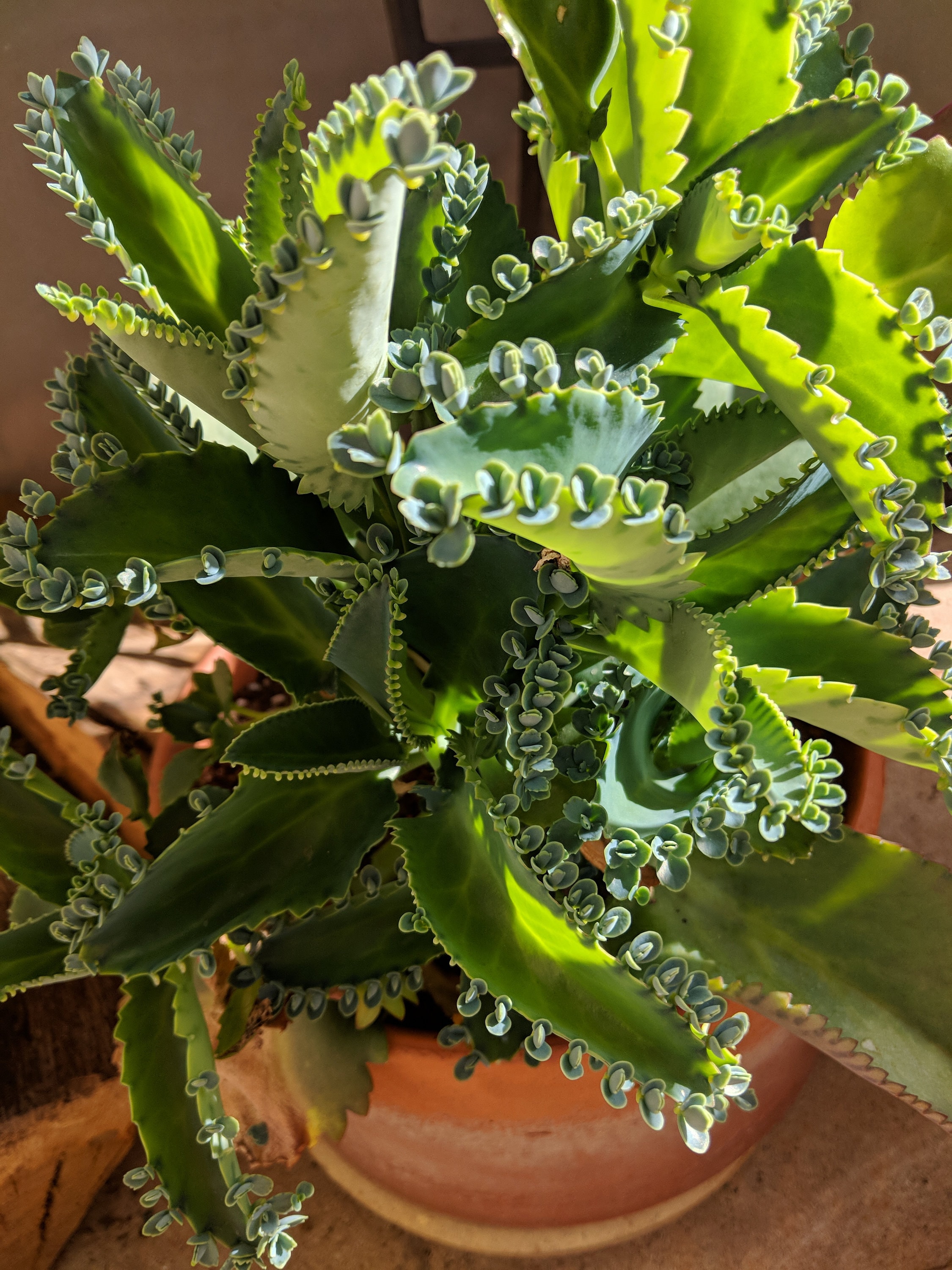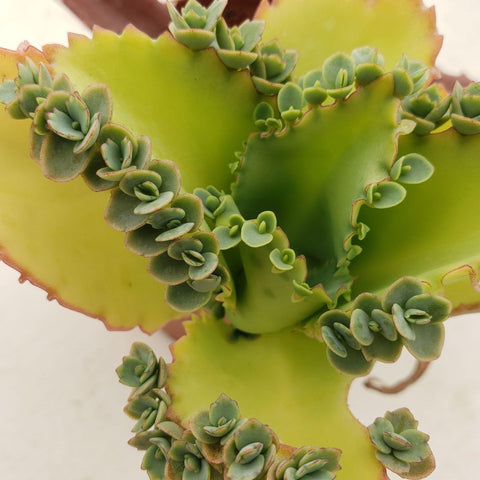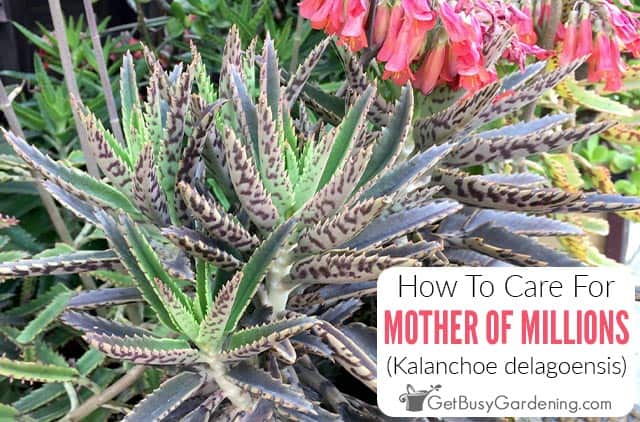Mother of Thousands is a succulent plant famous for the baby plants it produces on a single leaf. These small baby plants make the entire plant look appealing. Growing this plant is quite simple, and taking care of it is something that even beginners can do.
Some articles advise against purchasing mother-of-thousands plants since they are relatively simple to multiply. However, if the owner is good and consistent about taking care of them, they will flourish nicely.
To avoid confusion, this plant is also known by the popular names Devil’s backbone, Mexican hat plant, alligator plant, and mother of thousands plant. Its scientific name is Kalanchoe daigremontiana; it is a member of the Crassulaceae family and was formerly referred to in textbooks as Bryophyllum daigremontianum.
Thousands Mother Of For Sale:
Get Now
| Family | Crassulaceae |
| Scientific Name | Kalanchoe Daigremontiana |
| Other Names | Mexican hat, Devil’s backbone and alligator plant |
| Native | Madagascar |
| USDA Hardy Zone | 9 -11 |
| Light | Morning Full sun / Partial Light |
| Height | 3-4 feet |
| Width | 9-12 inch |
| Fertilizer | Liquid based |
| Soil | Well Drained |
| Toxicity | Leaves According to FDA |
Table of Contents
Mother of Thousands Care
Outdoor and indoor maintenance is simple, but outside of the garden, each requires a different strategy. Let’s discuss many aspects of caring for the Mother of Thousands Succulent plant:
Soil
To create a correctly blended, well-drained soil, combine 30% perlite with 70% succulent-cactus soil. Perlite will improve the soil’s drainage and airflow for roots. A succulent soil mixture ensures that water will stay in the soil for a specific amount of time, ensuring that the plant has enough water to grow and thrive.
Mother Of Thousands Watering
Basically Watering only functions if the soil is well-drained and the pot has enough drainage holes. Mother of thousands becomes upset if you keep them on the water, so try to avoid overwatering and always check the soil before giving them water. If it’s wet by 1-2 inches, don’t water; wait until the next day for it to dry. This succulent suffers greatly from overwatering, which puts the plants at risk of dying.
In the winter, they are in periods of dormancy during which they rest and slumber, so water them sparingly or simply spray them with water to make them moist but not wet. In the winter, they enjoy warmth.
Temperature
You shouldn’t place plants where the temperature is below 3-40° F because thousands of plants hate cold temperatures. This succulent prefers temperatures over 61 °F, yet it can handle 75 °F with ease.
For this plant, the USDA hardiness ranges from 9 to 11. People that cultivate them outdoors favor these areas.
Fertilizer
This plant can develop without additional plant food, but if you do or if you want to give your succulent better nutrients, use it every two to three months. Here, I’m using Cacti, Aloe Fertilizer.
If you would like to purchase, click here.
CONFIRM PRICE
Light
This succulent can tolerate partial or bright light, but you should avoid afternoon sun because it could burn the leaves in the summer heat. It is recommended to grow in a container or pots in a shady area of the house or in a spot with only two to three hours of light every day. Don’t move them into a deep, dark area either because the plants may die.
Although it can handle some full sun, it doesn’t affect the plant that produces thousands of leaves.
If you can keep them warm over the winter so they can stay healthy, that would be ideal.
Humidity
They can grow well in a typical room temperature and easily adapt to low to moderate humidity levels.
Growth Rate
When you plant baby plantlets, it takes two weeks for them to grow 2-3 inches, two months for them to be big enough to be called a plant, and six months for them to be considered fully grown.
Height
Mother of thousands has leaves that are 4–10 inches long and can reach a height of about 2-3 feet. The majority of individuals typically observe plants at a height of 1 foot.
Mother of Thousands Propagation
Propagation from mothers of thousands is simple and user-friendly. How Utilizing a mother plant for hundreds of plantlets makes propagation simple. Yes, it appears to be a large plant, but these baby plants are further multiplied to create a new plant. Why then did we require plant propagation from mother of thousands? In order to give thousands of succulents a new life, many individuals discover that the mother plants of these thousands of plants no longer have the capacity to produce seeds, leaving them entirely reliant on plantlets or baby plants. These are often small plants that occasionally resemble flowers growing on leaves. If you do reproduce, it’s a good idea because these succulents occasionally begin to fade or wilt due to issues like overwatering, intense sunlight, and owners’ negligence in not caring for the plant. By visiting a neighbor’s or friend’s home, pulling out the plantlets there, and planting them in your garden, you can even obtain this plant for free.
How to Procreate Mother of Thousands Instructions:
Remove Plantlets from the Mature Plant in Step 1.
First off, you may complete the task with just your hand and no pruning shears are required. Remove the plantlets, which resemble small flowers developing along the border of the leaves and are the mother of hundreds of offspring.
Take two or three plantlets if you are propagating.
Even if these succulents have a 90% success probability of growing, we should always carry backup plantlets to increase our chances of success.
3. It is simple to locate the young plants.
I can vocally tell you where and how to locate those little plantlets without using even a visual or photo. It looks like little flowers or plants as it grows among leaves.
4 Now create the soil mixture and make sure they receive the most advantages from it.
It’s crucial to select the best soil mixture, and I’m using a mix of perlite and succulent and cactus plants. To thoroughly combine that, use your hands or put on a pair of gloves.
5. Just sow the plantlets and give them a light watering.
It’s time to plant the plantlets; remember to carefully water them. On other days, merely mist the ground where these plantlets will be placed with water.
Enjoy it and skip the purchase the next time.
You get knowledge when you successfully propagate mother of thousands for the first time to produce a new plant. Now you can do it yourself and never buy another thousand plants again because they keep growing. Another benefit of these plants is that they produce many plantlets, making it simple for a cultivator or gardener to spread it.
7. Remember to give them water and sunlight.
Give them water anytime they ask for it, consistently. Before providing them with ample water once they are grown, always examine the soil. Indoors, you can put them close to the south-facing window, or you can grow them outside where they only get morning sunlight. Read my Caring Guide for Those with a Light Requirement. You can grow succulent plants in this way.
How to Repot Mother of Thousands Plant
Mother Of Thousands Pruning
Pruning is the only technique to manage Mother of Thousand plants’ excessive growth because they can reach heights of up to 3 feet. Yes, mother of thousands have unrestrained growth, which is why trimming is necessary every 6 to 9 months. While trimming, you can remove baby offshoots to create new mother of thousands plants. If you don’t prune them, they’ll get enormous and most of the leaves might fall to the ground. At that point, you’ll need time to conduct some cleaning as more and more leaves fall. We prune the dead foliage and any unhealthy leaves in order to prevent pests and fungus diseases.
Here are the instructions for pruning Mother of Thousands, step by step:
1. Locate dried stems, leaves, and long, overgrown vines.
Find some of the stems that have already turned orange from their original green color. You can also cut off any stems that are overly long and curly. It is possible to remove some sick, wilted, or desiccated leaves.
Use pruning shears for the cleanest cutting possible.
You should have a pair of pruning shears so you may remove any sick, long, unattractive stems, or overgrown leaves.
3. Several shoots or stems may be chopped down.
It’s time to clip some of the stems from the baseline if you discover several stems in a single pot and there isn’t room for the new root to emerge.
4. Clean up the area after pruning.
It’s time to clean up the area completely so it doesn’t appear bad.
5. Water it to help it recuperate from the trauma of pruning.
Place it in a partially warm area and keep it moist.
6. Take Pleasure in Trimming Overgrown Succulents Successfully.
When there is excessive growth, mother of thousands can be pruned every 6 to 10 months. This plant should be kept short to maintain its attractive appearance, therefore I prune it when I notice overcrowding. Avoid pruning them in the winter. You can do it throughout the growth season or wait for the winters to end.
Mother of Thousands Varieties
There is no need for pesticides because the Mother of Thousands plant has more than 29 types, each of which is robust and resistant to pest infestation. The majority of them were found in the African continent and are all members of the Crassulaceae family. Typically, this kind of species group goes by the name Bryophyllum. The most well-known examples are listed below:
A developed variant, Bryophyllum fedtschenkoi, with metallic greenish-blue leaves. This type will turn red or pink in the direct sunlight due to water loss. It produces bell-shaped, brown to reddish blooms that are of medium size.
Other names for Bryophyllum fedtschenkoi include aurora-borealis, south american air plant, gray sedum, and kalanchoe stonecrop. These names are based on geographic designations.
Madagascar, specifically in the south African region, is where Bryophyllum houghtonii was found. These plants, which mostly grow on the sides of roadways in tropical nations with a V-shaped leaf, are planted in tropical climate zones.
Bryophyllum houghtonii is also referred to as the Mother of Millions hybrid, the Devil’s backbone (an impressive-sounding moniker), the Good Luck Plant, and the Mexican Hat Plant.
Most Searched Questions:
Mother of Thousands dying
Numerous factors, including the same ones that affect every plant owner, might shorten a plant’s lifespan to a few months. The most frequent and discussed causes of plant death were overwatering, underwatering, excessive heat, or warm days that dried them out and absorbed the water retention, causing the plant to wilt and die if no further care was given. With persistent and appropriate care, only the owner can save this plant.
Mother of Thousands Plant Turning Yellow
If the leaves of your Mother of Thousands Plant start to curl and turn yellow, too much water may have been given to them, causing the roots to rot. In that case, move the plant to a spot with three hours of direct sunlight.
If there is too much water, the check pot has a hole in it that shouldn’t be blocked by sand; otherwise, there will be a drainage problem and water will remain on the soil. Avoid placing them in direct sunlight as this could make the plant limp.
Keep in mind that this plant has a higher success rate of survival and that it can recover over time. If this is the case, avoid using fertilizer because too much fertilizer will quickly destroy any plant.
Mother of Thousands Plant Flower
The fact that this plant blossoms flowers is not a well-liked feature because the baby plantlets receive all the praise and glory and are the center of attention due to their gorgeous leaves. Flowers are useless if they serve no purpose and lack any striking beauty.
They do look stunning on them, but how can anyone notice them if they don’t bloom?
Mother of Thousands Plant Benefits
Mother of thousands benefits from the leaves of this plant to aid them whenever there is a water shortage. When you touch them, you can still feel the majority of the cold water that they formerly stored. Numerous studies on the therapeutic applications of mothers have revealed that they contain anti-inflammatory, antibacterial, and anticancer qualities. If there were no rainy days or a dry climate, these plants would hold water in their leaves, which they might use to survive for several months.
Mother of thousands are used in some cultures to treat a variety of illnesses, such as common coughs, wound healing, having some qualities that can prevent cancer damage, and having advantages like anti-inflammatory properties. Despite the limitations of the study, the early results point to the extraction’s antibacterial advantages. It would still offer the assistance necessary to solve some issues. (SOURCE)
Lotusmagus exclusively publishes content that has been prepared for educational websites because we do not advocate using any plant extracts to cure a variety of human illnesses.
Mother of thousands have an advantage over other houseplants that employ CAM method to conserve water that can be wasted in the summer’s hottest months of June and July.
The same principle is employed to assist humankind since, whereas most plants produce CO2 at night, mother of thousands absorbs it, which is advantageous, and can then release oxygen the following day.
A tree known as the peepal tree uses the CAM mechanism to manufacture oxygen day and night by performing photosynthesis at night and releasing pure oxygen.
Kalanchoe delagoensis benefits
Kalanchoe is a perennial plant that is utilized to treat conditions including rheumatoid arthritis, gastric ulcer, kidney stones, and more, claims study researchers. Scialert claims that a different plant known as kalanchoe pinnata has anticancer, antidepressant, and other medicinal benefits.
Conclusion
Problems with Honeysuckle: Pests, Diseases, Lack of Flowers, Woody?
Care Instructions for String of Nickels: Soil, Fertilizer, and Propagation (Step by Step)
Plant Care, Benefits, Propagation, and Pruning for the String of Pearls (Full Guide)
Moon Cactus Grafting: A Step-by-Step Guide



